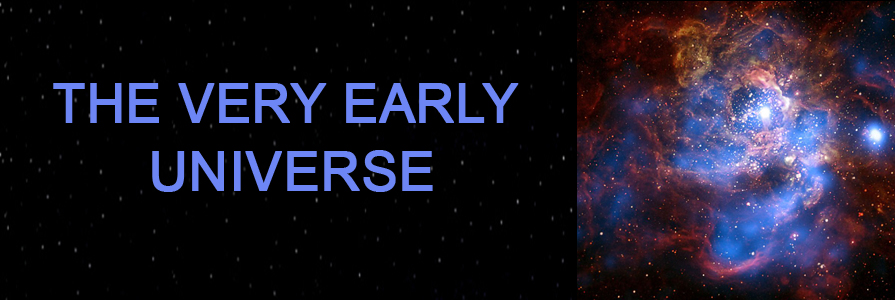
Overview
The following is the current "theory" of the very early universe. Inflation, while not conclusively confirmed, is generally believed to be essentially correct in its overall implications if not in exact detail. Cosmologists believe that Inflation may be tweaked in the future but the essentials of it will survive. Several signs of Inflation have been observed, but not enough to "confirm" it. Below is a illustration that breaks down the early universe by "Era" of significant events.
Major Events Of The Early Universe
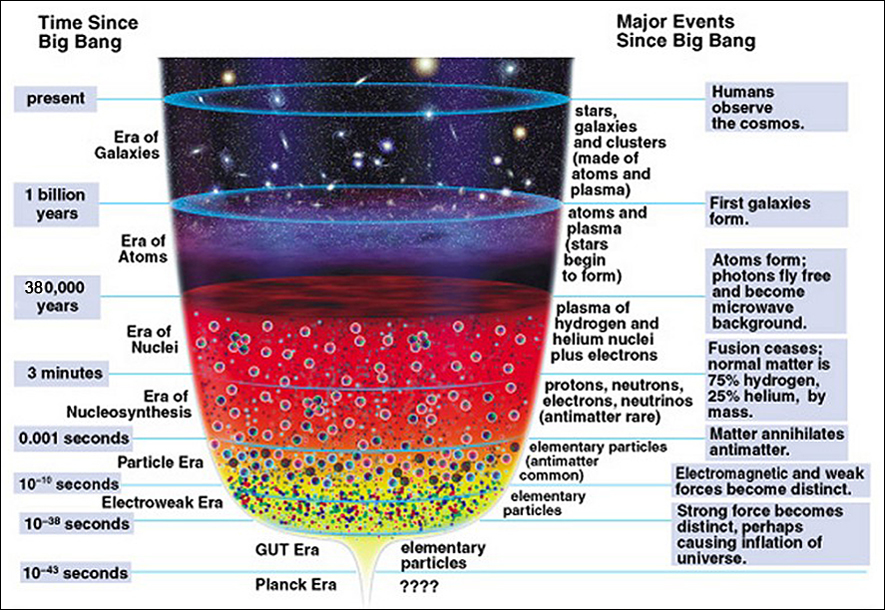
The Planck Era (Big Bang To 10^-43 Seconds)
The time from the exact moment of the Big Bang until 10^-38 of a second later is referred to as the Planck Era. While we have no way of knowing what this era was like from the equations of physics (as they break down in this era), it is "assumed" to be as follows. The universe was a tiny hot gaseous soup (a plasma) consisting of packets of "primal" particles at extremely high energies. The universe was smaller than the size of a proton. During this phase physicists believe matter and energy were not separated as they are currently. The primal particles were packets of radiation unlike anything we know today. Also, the four primary forces of the universe as we know them today were believed to be one united force. The temperature of the universe was 1 x 10^32 degrees Celsius. This hot thick soup was intense and everywhere. It also began to instantaneously expand and cool extremely fast. Top
The GUT Era (10^-43 To 10^-38 Seconds)
The Grand Unified Theory (GUT) is a model in particle physics in which at very high energy and temperature, the three fundamental forces (the Strong Nuclear Force, the Weak Nuclear Force, and Electro-magnetism) of the Standard Model are merged into one single force. With the exception of gravity, physics in this era are described by GUT Theory. The GUT "Era" begins at 10^-43 when gravity separates from the other three unified forces, which do remain unified. The GUT Era ends when Inflation begins at 10^-38 seconds. Top
Electroweak Era (10^-38 To 10^-10 Seconds)
The Electroweak Era began at 10^–38 seconds after the Big Bang, when the temperature of the universe cooled enough to separate the Strong Force from the Electroweak Force (the name for the two unified forces of Electro-magnetism and the Weak Nuclear Force). The Electroweak Era contains two sub-eras - Inflation and Reheating.
Inflation (10^-38 To 10^-35 Seconds)
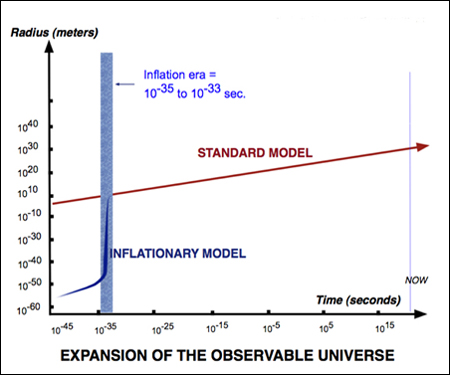
Alan Guth, now a Professor at MIT, proposed an Inflation addition to the Big Bang Standard Model in 1981. As shown in the chart at the left produced by Guth himself, the universe went through an expansionary phase that was faster than the speed of light. (Space-time is not limited by the speed of light, only objects "within" space-time are.) In this brief interval of Inflation, the "observable" universe expanded by a factor of about 10^70 (1 followed by 70 zeros) from being unimaginably smaller than a subatomic particle to about the size of a grapefruit. That is the equivalent of going from about the size of a grape to the current size of the observable universe in the blink of an eye - awesome!
Note that Inflationary theory does not say anything about the "whole" universe, only the observable universe. The Inflationary model does not make any statement about the whole universe which could in fact be infinite. See paper on Inflation by Alan Guth. Inflation ends when the inflation field decays into ordinary particles in a process called "reheating", at which point the ordinary Big Bang expansion begins.
What caused Inflation to happen? Cosmologists are not sure of this and several theories exist. Guth proposed that the super cooling initiated a anti-gravitational field which then caused a violent growth spurt. There were some side issues with Guth's proposal and Andrei Linde of Stanford suggested "New Inflation" which could have various triggers, among them a random fluctuation of the initial field. There are several other theories floating about including one from Paul Steinhardt of Princeton. Steinhardt has championed an alternative to Inflation, in which the universe begins from a collision between a pair of universes known in string theory as "branes", short for membranes (see Branes in string theory sister page).
The important cosmological feature added by Guth is the rapid expansion of the very early universe which then blends in very smoothly with the standard Big Bang theory. Inflation solves the three issues with the initial theory (see theBig Bang Page.) and has now been incorporated as part of the standard Big Bang Theory. The recent WMAP satellite measurements are very consistent with the Guth type inflation models providing the first soft evidence for Inflation. (See the WMAP section under Early CMB Maps on the Microwave page.)
To Inflation purists, the Big Bang never really took place. Inflation was the start of the universe as we know it and all particles, stars, galaxies, etc. came about as a result of Inflation. There was no Big Bang explosion per se. Top
Reheating (10^-35 to About 10^-10 Of A Second)
Inflation was a period of super cooled expansion and the temperature dropped by a factor of 100,000 or so and continued to be cool during this phase. When Inflation ended the temperature returned to the pre-Inflationary temperature, back up by a factor of 100,000. This period is called "Reheating".
The huge potential energy of the inflation field suddenly decayed and filled the universe with elementary particles and radiation similar to water vapor in the atmosphere condensing into water droplets forming a cloud. Because the fundamental driving principles of Inflation are not known, this process is not well understood.
During Reheating, the elementary particles - photons, gluons, and quarks - were formed, but in a dense plasma state. Quarks and anti-quarks began to annihilate each other. However for reasons not yet understood, the mutual destruction of quarks and anti-quarks ended with a surplus of quarks. Because of this discrepancy, i.e. a surplus of quarks (matter), all galaxies, stars, planets, and human beings exist today.
Also, the three additional fundamental forces - the Electro-magnetic Force, the Strong Nuclear Force, and the Weak Nuclear Force - formed and then separated during this time according to the Grand Unified Theory. The universe, as we now know it, had evolved. The laws of physics and the four forces of nature began to apply. The fundamental particles had mass, but the temperature of the universe is still too high to allow quarks to bind together to form neutrons and protons. Reheating ended at about 10^-10th of a second. Top
The Particle Era (10^-10 To 10^-3 Seconds)
As the universe continued to cool, the particle era consisted of the formation of two particle families - hadrons and leptons. Hadrons are made up of quarks. Hadrons then formed two additional families - baryons and mesons. Baryons are "normal stable everyday matter" consisting of three quarks. Mesons are "short lived unstable particles" made of one quark and one anti-quark. All of the new mesons quickly annihilated each other leaving only protons and neutrons which would make up the nuclei of future atoms.
The formation of hadrons was followed by the formation of leptons. Leptons consist of electrons, neutrinos, muons and taus. Muons and taus are very unstable and quickly decay. During this period most of the matter in the universe consisted of leptons and their anti-particles. The lepton era drew to a close when the majority of leptons and anti-leptons annihilated one another, leaving a comparatively small surplus of leptons to populate the future universe. The lepton epoch ended at about 10^-3 seconds. Top
Big Bang Nucleosynthesis (10^-3 Seconds to 3 Minutes)
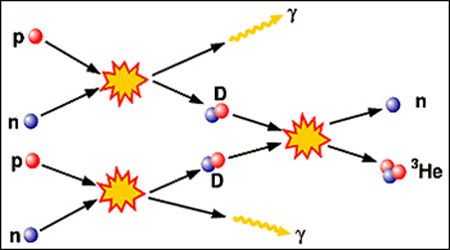
After Inflation, the universe slowed down to the normal "Hubble Rate" expansion and was filled with radiation and elementary particles, sometimes called "quark soup". As the universe continued to cool, new particles were formed out of pre-existing ones. This early formation phase is called the Big Bang Nucleosynthesis (BBN). With the temperature falling below 10 billion Kelvin, BBN took place from about 10^-3 seconds to about three minutes.
The diagram at the left illustrates two of the common nuclear reactions which occurred during the BBN. It shows single proton ions and neutron ions combining to form deuterium nuclei, D, (containing one proton and one neutron) plus the emission of high energy photons, γ. Subsequently it shows two deuterium nuclei fusing to produce one nucleus of helium-3 (with two protons and one neutron) and one free neutron. Note that "atoms" were not yet forming, the above reaction shows just the "nuclei" of future atoms forming from ions. Experiments can be done in labs today demonstrating these early BBN nuclei reactions.
The BBN theoretical calculations result in a nuclei abundance of about 75% hydrogen (1 proton nucleus), about 25% helium (2 protons and 2 neutrons in the nucleus), and about 0.01% of deuterium (1 proton and 1 neutron nucleus). Without this abundance of hydrogen nuclei, there would be no water and therefore no life as we now know it. That the observed hydrogen and helium abundances in early distant galaxies are very consistent with the above theoretical calculations is considered "strong evidence" for the Big Bang Theory. Big Bang Nucleosynthesis is one of the three pillars of support for the Big Bang Theory. Measurements from the WMAP satellite over nine years of collecting data (2001 to 2010) has confirmed the above ratios with much greater precision.
One nice feature of the BBN is that the physical laws that govern the behavior of matter at these energy levels are very well understood. Hence the BBN lacks some of the speculative uncertainties that characterize earlier periods in the "theoretical" life of the universe. During all this time, electrons and photons interacted with each other so intensely (instantaneous collisions) that the universe was dark (opaque), no light (photons) could escape the darkness. Top
The Nuclei Era (20 Minutes to 380 Thousand Years)
The Dark Ages. After the first three minutes, the universe obeyed the Standard Model and settled down to a much longer period of expansion and cooling in which change was much less dramatic. High energy radiation (photons) dominated the cosmos. As the universe continued to cool, more and more matter was created. Expansion caused radiation to lose more energy than matter so that after a while, matter (nuclei) particles exceeded massless particles (photons). About 70,000 years after the Big Bang, radiation and matter were about equal in density, shortly thereafter matter began to dominate.
Recombination (380,000 Years) For the next 310,000 years the universe continued to expand and cool, but was still fiery hot and dark. Any visible light was immediately scattered by collisions with the ubiquitous electrons and protons. It contained only the simplest elements, mostly hydrogen and helium ions. As the universe cooled further, the electrons (with a negative charge) begin to get captured by the ions (with a positive charge) forming atoms (electrically neutral). This process happened relatively fast and is known as "recombination". The first bits of structure began to form. These small clumps of matter grew in size as their gravity attracted other nearby matter. At about 380,000 years of cooling, light (photons) began to travel through the spaces between the atoms which now "bond" the electrons in their orbits. The universe had become transparent.

Cosmic Microwave Background (CMB). The first early radiation that could freely travel was the CMB, the remnants of which we can detect in the current universe 13.75 billion years later. 380,000 years is the earliest point in time we can ever look back and "see" because everything before that was part of the dark ages.
Note the CMB picture to the left taken by the European Space Agency (ESA) Planck satellite. The Planck satellite launched in 2009 is the third satellite exclusively designed to map the early CMB. NASA has previously launched the COBE in 1989 and the WMAP in 2001. Check out the Cosmic Microwave Background web page.
Currently, the earliest galaxy we can "see" is MACS0647-JD which formed about 420 million years after the Big Bang. Top
Early Radiation vs. Matter
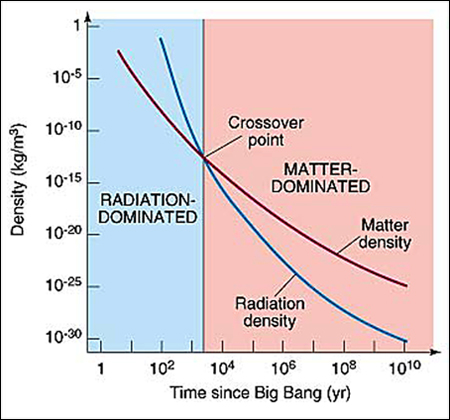
On the very largest scales, we can regard the universe as a roughly homogeneous mixture of matter and radiation. As the universe expanded, the number of both matter particles and photons per unit volume decreased. But radiation is also reduced in energy by the acceleration rate, so its density falls faster than that of matter as the universe grows. Currently, matter dominates radiation in the universe. Matter consists of the familiar building blocks of atoms - protons, neutrons, and electrons, as well as mysterious dark matter.
Most of the radiation in the universe is in the form of the cosmic microwave background. Surprisingly, although the microwave background radiation is very weak, it still contains more energy than has been emitted by all the stars and galaxies that have ever existed. The reason for this is that stars and galaxies, though very intense sources of radiation, occupy only a tiny fraction of space. When their energy is averaged over the volume of the whole universe, it falls short of the energy of the microwave background by at least a factor of ten.
Even though today the radiation density is much less than the matter density, there was a time in the past when they were equal at the crossover point. Before that time, radiation was the dominent constituent of the cosmos.